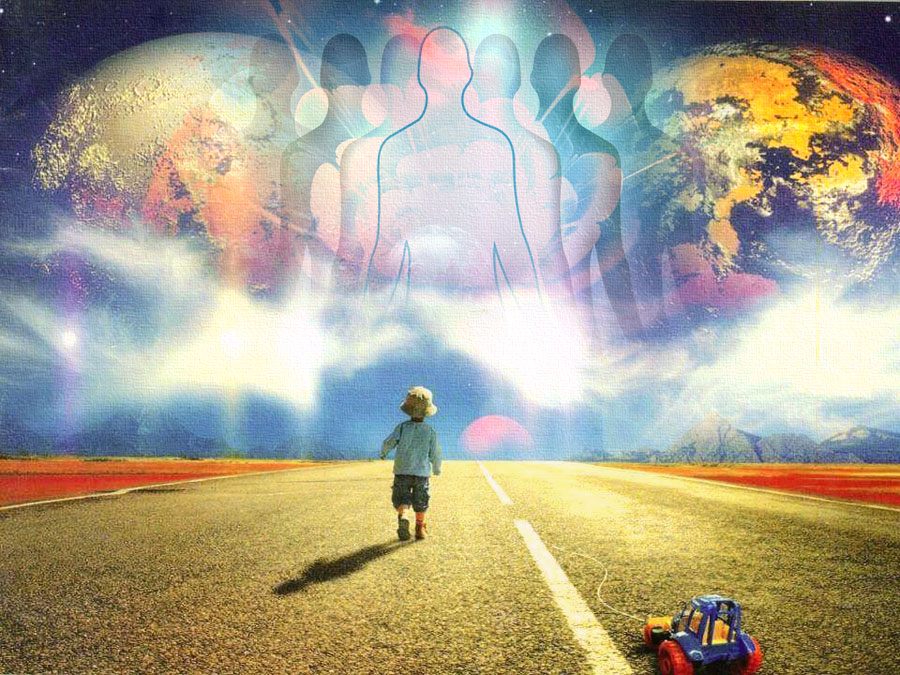Children’s Past Life Memories And Healing
 by Carol Bowman
by Carol Bowman
Young children all over the world have spontaneous memories of previous lives, regardless of the religious beliefs of the parents. It’s a natural phenomenon. Children usually begin speaking of “when they were big before” or “when they died” around the age of three, and may speak of their memories for a period of a few years. Many of the memories children recall are of traumatic deaths, which may continue to affect a child in their present life as phobias and other emotional problems. By combining what I’ve learned from collecting my own cases of children’s past life memories for more than twenty years, and from the large body of research of spontaneous past life memories from Dr. Ian Stevenson, with the healing model of past life therapy with adults, I derive a method of healing traumatic past life memories as they emerge spontaneously in early childhood. By studying the cases of children who speak with conviction of their other lives, we also observe that many aspects of the child’s present personality have carried forward intact from the past life: behaviors, emotions, phobias, talents, knowledge, the quality of relationships, and even physical symptoms. The fact that these personality traits carry forward suggests a new way of looking at personality formation and a theory of personality that spans lifetimes. The children’s cases also add an important piece to the metaphysical discussion of the survival of consciousness after death, because it is clear from the cases that some form of personal consciousness continues from one life to another.
INTRODUCTION
Young children have spontaneous memories of their previous lives. It is a natural phenomenon observed in children all over the world, regardless of their parents’ beliefs. Some young children start talking about their other families, spouses, children, what they did before, and how they died soon after they begin talking. These matter-of-fact statements made by such young children can be quite shocking to an adult who knows the child. Even if a child doesn’t speak directly about a previous life, the memories can manifest as behaviors, phobias, unlearned abilities, talents, wisdom – almost any aspect of a child’s personality. The explicit memories and statements generally fade by the age of seven.
There are many advantages to be gained from studying these memories. As you read each of the cases here, I invite you to keep three ideas in mind and reflect on their implications. First, these memories offer us the purest evidence for the continuation of a personal consciousness after death. This is empirical evidence that can be validated and examined. Second, we can see that many types of personality traits carry over intact from one lifetime to another. This offers an expanded explanation for the origins of personality that stretches beyond the limits of heredity and environmental conditioning. And, when you see it, it’s logical and makes sense. Third – and this is where my work diverges from others in this small field – when children talk about traumatic past life memories, especially their deaths, it is a precious opportunity for healing past life wounds to the soul. It is the time early in life when patterns or issues brought forward from past lives can be healed, resolved, and corrected so they are not carried into adulthood – or into future lives.
DISCOVERING PAST LIVES
Until I experienced this phenomenon in my own children in 1988, I had no idea that children could remember their previous lives. I was a believer in reincarnation. My belief came from a direct experience of heightened awareness that I experienced as a college student in Boston in the late 1960’s. I realized that we don’t die, that some part of our consciousness continues after death. I wasn’t sure how this affected me in my present, personal, day-to-day existence, though. It wasn’t until I became very ill that this question took on real and immediate significance.
I developed chronic lung problems – pneumonia, pleurisy, asthma – in my mid-thirties. During the height of my illness, I had a lucid waking vision: I saw myself as an adult male in his mid-thirties, lying in bed, coughing up blood. I knew it was “I” who was dying of consumption. In my vision I even saw a procession of mourners and a horse-drawn carriage from a vantage point above the treetops, and I knew I was witnessing my own funeral from above and out of that body. The vision was so real, and its message so meaningful, it scared me. I wondered if I were destined to again die young from the same lung ailments, leaving a husband and young children behind.
As fate would have it, soon after this vision I met past life therapist Norman Inge. My two-hour session with Norman changed my life. In the regression session I saw in more detail, with strong emotions, the nineteenth-century life in which I died of consumption, and a World War II life in which I was a young mother who died in a Nazi gas chamber. In both lives I died from trauma to the lungs. After “reliving” these traumatic deaths, and understanding the context of these lives and deaths, I started getting better. My illness went into remission. Also, I saw the seeds of my early personality and scenes from my childhood in a new light: childhood dreams, waking visions, phobias, an early interest in the piano, unusual childhood games, and certainly my lung problems all related directly to the lives I recalled in the regression session. I saw that I carried residues of the past life experiences throughout my life, which I had only glimpses of in childhood. Through the regression, I was able to finally let go of the grief, sadness, anger, and shock that I had been carrying in my body and soul from those two deaths.
A year after my regression session, my five-year-old son, Chase, developed a phobia of loud booming sounds. He was a lively, fearless child, and the phobia seemed to come out of nowhere. We became aware of it at a Fourth of July fireworks display in Asheville, North Carolina, where we lived at the time. On that particular evening, as we sat atop the sloping hills of the municipal golf course, we saw people sprawled on blankets on the hills below. Since we had taken Chase to other fireworks displays before, we were surprised when he became hysterical as the loud booming sounds began to reverberate around the hills of Asheville. He was so distraught that I had to take him home and leave my husband and daughter behind. It took me about an hour to calm him down by holding him and rocking him on our back porch.
I was puzzled by Chase’s unusual behavior. I reasoned that he must have been overly stimulated from the day’s activities with our friends and their children, or he had overdosed on sugar. Things like this happen with children, so I filed it away in my mind as a curious anomaly. Three weeks later, we went to a municipal indoor swimming pool for the first time. When we entered the building we heard loud booming sounds as people jumped on the diving board and the sound reverberated off the walls. Again, Chase became hysterical and pulled me out of the building. At this point I realized it was the booming sounds that deeply frightened him.
I asked him about it, but he really couldn’t answer me through his sobs. I couldn’t think of anything in Chase’s short life, or even my pregnancy with him, that could cause such a pronounced fear of these sounds. Also, I was a little concerned because he was due to start kindergarten in a few weeks. I could imagine them calling me from school and saying, “Could you please take your son home. He’s hysterical and we can’t calm him down.” I had no idea what to do.
A couple of weeks later, Norman Inge, the hypnotherapist who had regressed me a year before, was visiting us in Asheville to work with a number of my friends, including my medical doctor, who were all intrigued by my rapid and total recovery from my illness. They wanted to try past life regression.
One afternoon during Norman’s visit, Chase, my nine-year-old daughter, Sarah, and I were sitting around the kitchen table having tea and cookies with Norman. It occurred to me that since Norman was a hypnotherapist, perhaps he could give Chase a posthypnotic suggestion so the loud booming sounds wouldn’t trigger such fear in him. I had absolutely no idea what we were getting into when Chase agreed to let Norman help him with his fear.
Norman simply said to Chase, “Sit on your Mom’s lap, close your eyes and tell me what you see when you hear the loud sounds that scare you.”
Immediately Chase said, “I am a man. I’m a soldier. I have a dirty uniform on. I’m holding a gun with a long sword at the end. I’m crouching behind a rock. I’m scared, confused. There’s smoke everywhere. I don’t even know who I’m shooting at.”
I think I went into a mild state of shock at that moment; we were in new territory. My little boy, who never played war games, and didn’t even own a toy gun, was talking about a soldier. It didn’t compute. My mind was quickly scanning everything Chase may have been exposed to on TV, in the movies, or from his playmates to explain what was happening. I was a stay-at-home mother and knew much of what Chase had been exposed to. The only television our kids were allowed to watch was Sesame Street and Mr. Rogers. I was trying to figure out where he could have gotten this – which Sesame Street episode was this? Which Disney movie?
Norman, who had many years of experience doing past life regression therapy with adults, immediately sensed Chase was accessing some past life material. Norman knew what to do. He encouraged the flow of Chase’s memory by asking open-ended questions, saying to him, “Well, then what happens?
Chase said, “I’m behind a rock, I’m scared and confused. All of a sudden I’m hit in the wrist.” Chase clutched his right wrist.
“Then what happens?”
“I black out.” Norman continued, “Then what happens?”
“They took me to a hospital, but it’s not like a regular hospital. There are big poles in the ground with some material covering them. They put me on a bed, but it’s not like a regular bed. It’s a hard wooden bench. They bandage my wrist, and they tell me I have to go back to battle. I don’t want to go. I don’t want to be there shooting at other people. I don’t want to kill anyone. I miss my wife and family.”
At this point, the hair on my arms stood on end. It’s quite startling hearing your five-year-old talk about his wife and family.
Norman quickly picked up on Chase’s confusion and anguish. He intervened and in very simple language Norman said to Chase, “We live many different lives on earth. We take turns playing different parts, like actors in a play. We learn what it means to be human by playing these different parts. Sometimes we are soldiers and kill others in a battle, and sometimes we are killed. We are simply playing our parts to learn.” I wondered if Chase could understand these concepts. I was reassured as I felt his body relaxing as he sat on my lap. The distressed look on his face melted away. Norman’s words seemed to be helping.
Norman said, “Then what happens?”
Chase continued, “They bandage my wrist and they made me go back into battle. I’m walking back to battle. There are chickens on the road. I see a cannon on a wagon. The cannon is tied down with ropes. The wagon has big wheels and is pulled by a horse.” As Chase is describing what he is seeing, I’m trying to figure out what war this may have been, when they used horses and wagons.
He continued, “They make me go behind the cannon.” And with that he opened his eyes, hopped off my lap, grabbed a cookie, and ran off to play with his Legos. I was stunned. Norman reassured me that Chase was probably remembering a past life – a battle memory that had been triggered by the loud booming sounds of the fireworks. He said, “Let’s just see what happens, if Chase’s fear goes away.”
My daughter, Sarah, who was sitting with us and closely following Chase’s story piped in: “Mom, that place where Chase said he was shot in his wrist – that’s where his eczema is!” I think I was so shocked by what I was hearing that I hadn’t made the connection. But Sarah had. Since Chase was a baby, he’d had chronic and severe eczema on the inside of his right wrist, the same spot where he said he was shot in battle. He would scratch the eczema so relentlessly at night that it would bleed. I learned to bandage his wrist at night so I wouldn’t have to wash the blood from his sheets every morning. I thought this was very interesting, indeed. Chase remembered how they had bandaged his wrist before he went back to battle – an interesting overlay of events. Chase appeared to have a somatic memory of that battlefield injury, as well as a visual and emotional memory.
The upshot of this fifteen-minute or so episode in my kitchen was that within a few days his chronic eczema disappeared. I was surprised, because I had taken him to several doctors for the eczema, and we had tried homeopathy, food elimination diets, and antibiotic creams. Nothing had worked. The eczema had not responded to any medical treatment. But after the recollection, the eczema completely disappeared. A few weeks later, Chase asked for his first drum set for his sixth birthday. From that point on, he made large booming sounds all of the time. Now, at age twenty-seven, he is a professional drummer, among other things. Looking back, it is ironic that the source of his greatest fear as a child is now the source of his
greatest delight.
I was still reeling from Chase’s extraordinary experience, when Sarah asked Norman if he could help her with her fear of fire. We first became aware of Sarah’s phobia a year before when she spent the night at a friend’s house and they watched a movie with a large explosion and fire scene in it. Sarah became hysterical. Her friend’s mother brought her home late at night explaining that Sarah wouldn’t calm down. We were very puzzled by her strong reaction.
Sarah was an active, confident girl and this was out of character for her. When we asked her about it, she said that she had always been terrified of fire, and actually hid a little bag under her bed with her favorite dolls and some clothes, which she would grab in case our house caught on fire. That was also a surprise! Norman used the same technique with Sarah. As she sat at the kitchen table, he instructed her to close her eyes and tell us what she saw when she felt the fear of fire. Immediately, nine-year-old Sarah described herself as an older girl, around twelve years old, who was in a simple wooden house along a dirt road. She said she didn’t go to school because “they didn’t believe that girls needed education.” She said she had a brother who was disabled in some way, who couldn’t help around the farm.
Norman encouraged Sarah to “move ahead to the time when the fear of fire started.”
Sarah’s perspective immediately shifted. She spoke with great fear in her voice in the first-person, present tense. She told us that she woke up suddenly and smelled smoke. She knew the house was on fire and panicked. She ran out of the room looking for her parents and couldn’t find them. Suddenly the bottom of her nightgown caught fire as flames came up through the floor. She was trapped. Sarah was completely engaged in the memory. She cried with deep anguish and asked, “Why don’t they save me? Why don’t they get me out?” She said she knew she was about to die.
Suddenly, she was calm. I could see her body relax. She reported that she felt herself floating above the treetops, feeling lighter, relieved that the life was over. She could see her house below and saw that her parents were crying and waving frantically at the house. In that moment, she began to cry again. She now understood that her parents had really loved her, and had tried to save her but couldn’t. She said that she carried the false belief that they hadn’t loved her into this life. With that realization, Sarah became peaceful.
A few days later, Sarah unpacked the bag with her dolls and clothes that she kept under her bed. Her “irrational” fear of fire went away.
That day changed my life, too. I became obsessed with understanding what happened to my children, and wondered if other children had these memories too. If so, had other children experienced healings by talking about them?
Within weeks after my children’s amazing experiences, we became very busy and involved in a move from Asheville to suburban Philadelphia. Even though I was completely intrigued by their memories, I was too busy to think much about it as we adjusted to our new lives in our new home.
Six months after we moved, Chase and I were eating breakfast alone. As he was spooning his cereal he said, “Mom, remember when I was a soldier?”
He had my full attention. I said, “Yes.”
He said, “I talked funny.”
I said, “What do you mean you talked funny? Did you speak English?”
He said, “Yes. You know how some black people talk? Well, I was black.” That was it. He had an abstracted, faraway look on his face while he was remembering this, then he went back to eating his cereal.
I thought about this afterwards, and realized that Chase hadn’t known any African-Americans in Asheville and had only recently been exposed to the cultural diversity of Philadelphia. I also thought it was oddly amusing that in this life Chase is a red-haired, very white skinned person. He was the kid at the swimming pool who had to wear a t-shirt and be smeared with sun screen from head to toe.
He didn’t say a word about his memory again for a while, until the first Iraq war started in 1991. He was then seven and in second grade. I picked him up from school one day and he seemed very upset. I asked him what was wrong. He said, “They’re putting yellow ribbons all over the school because of the war. Mom, they have no idea what war is really like. They’ll never make me fight again!”
He told me that more of his memory of being a soldier was coming up again. I asked him if he wanted to talk about it when we got home. He agreed. By that time, I had begun my training in hypnotherapy and past life therapy. I felt I was ready for whatever might come up with Chase.
When we got home, I said, “Just close your eyes, Chase, and tell me what you see, what you’re feeling.” This was more than two years after his first spontaneous recollection. I grabbed a pad so I could record what he was recalling verbatim. He went back to exactly the same scene had had described when he was five, as a soldier crouching behind a rock with his rifle. He remembered the injury to his wrist, the field hospital, his gun, and the cannon being pulled by a horse on a dusty road. He even remembered the chickens walking on the road. I was curious and asked him, “What do you remember before the war?” He described himself as being a “free” (his word) black man who made pots in a town called something like “Collosso.” (We were never able to determine where that was.) He remembered his wife, who wore petticoats (a word I didn’t think he knew), and who always wore a kerchief around her head. He remembered his children. When I asked him when this was, he said, “Eighteen-sixty something.” He went through the story, and when he got to the point where he said, “They order me back into battle behind the cannon,” this time he continued with his recollection: “Suddenly I’m floating above the battlefield. I feel good that I’m done. I see the battle and smoke below. As I look down on the battlefield everything is still and smoky – nothing is moving down there. I feel happy that I’m done. I get to go to a happier life. I float over my house. I see my wife and kids. I say good-bye to my family. They don’t see me because I’m in spirit [his word], but they know I’m dead.”
I asked Chase what he learned from his lifetime as a soldier. His answer amazed me: “Everyone has to be in a war. It balances everything out. Not necessarily die in a war, but experience it. It teaches you about feelings. It gives you a sense of how other people feel. It’s a bad place. I skipped World War II. I was ‘up.’ I was waiting for my turn to go back to a more peaceful time. I had a short life in between.”
After that, Chase seemed at peace with his Civil War memory. He seemed to have closure after remembering his death and “saying good-bye” to his family. And the strong emotions around that event didn’t surface again. About six months after his last recollection he came to me and said that his memories of the battle were beginning to fade, and that he wanted to draw what he recalled so he could remember it. To this day, he still has a visual memory of that
battlefield.
In 1994, when Oprah did a show on children’s past lives, her staff hired a Civil War historian to see if they could establish Chase’s identity in that life. Since Chase didn’t remember his name, they couldn’t. But one historian contacted me and told me that based on Chase’s aerial diagram of the battlefield, he thought the battle had been near Richmond, possibly. He said that there were black regiments fighting in that area, too.
PAST LIFE PATTERNS
I began my research on children’s past life memories after Chase and Sarah’s experiences. This was in 1988, pre-Internet days. I began by asking parents in our Asheville community, at my kids’ schools. I got a few stories from mothers I knew. They said their children’s remarks were so unusual, that they had never forgotten them. They suspected they might be past life memories, but had never heard of this phenomenon before. I needed more cases. I placed reader ads asking for cases in the A.R.E. magazine (The Edgar Cayce Institute) and in Mothering magazine. I wrote an article for the A.R.E. magazine and one for The Journal of Regression Therapy.
I started getting letters from parents all over the country who believed their young children were currently talking about previous lives, or had done so in the past. I followed up on the phone with the parents who contacted me. Most of them had never believed in reincarnation before, but were left wondering if reincarnation was the explanation for what they were witnessing after their children talked about “when I was big before,” or “when I died.” They were relieved to talk to me and find out that their children’s experiences were not a sign of mental illness, that other parents were experiencing this with their children, too. They felt reassured that they were not alone. And they were most grateful for any guidance in how to respond to these memories and help their children.
As I collected more and more of these stories, I found some common patterns to these memories, which I distilled into The Four Signs in my first book, Children’s Past Lives.
They are:
1. Matter-of-fact tone
2. Consistency of story over time
3. Knowledge beyond experience
4. Corresponding behavior and traits
When children talk about these memories – these are mostly two-, three-, and four-year-olds, some still in diapers – they have a very matter-of-fact tone of voice. They are unusually serious and may even sound more grown up. They are insistent that what they are relating actually happened to them. When a puzzled adult questions them and asks, “Did this happen on TV?” They will say, “No, to me.” The most noticeable statements are about those things that such a young child couldn’t possibly know from their own limited experience. Or, most telling, a child will make direct statements about “when I died.”
Some children may make only one statement about a previous life. Or, they will talk about it repeatedly over days, months, or even a few years. I found it fascinating that the details of Chase’s story remained consistent over a period of about two and a half years. The core of the story never changed. I have found this with many other cases as well. As children develop more vocabulary, they elaborate on the story, reflecting their increased vocabulary and language skills, but the core of the story remains the same.
Children also have personality traits, behaviors, skills, phobias relating to their past life story. In Chase’s case, he had a phobia relating to his battlefield experience, and he was never interested in playing war games or with toy guns. Sarah had a phobia of house fires and took the precaution of preparing a bag with essentials in case she had to escape quickly.
Sometimes children will actually have a physical correspondence, or a body memory, that corresponds to the past life story, as with Chase’s eczema on the site of his battle wound. You will see more examples in the following cases.
In the more striking cases of children’s memories, there are usually more than one sign present. For example, along with the statements, the child will exhibit behaviors or have emotions relating to the memory they speak of. And, it can work in reverse: a child may have a phobia of water, will not go near it, or will have breathing difficulties, but will not make any statements about a previous life. In these cases, some gentle probing may elicit a past life story.
See Part II here.
Posted in Past Life Therapy, Reincarnationwith comments disabled.





